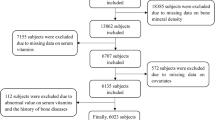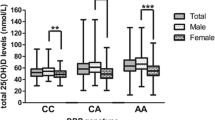Abstract
Recent studies have suggested that hyperhomocystenemia and low plasma folate are associated with fracture and also bone mineral density (BMD) and that they may contribute to the pathogenicity of osteoporosis in postmenopausal women. However, as plasma total homocysteine (tHcy) and plasma folate can be regarded as short-term markers when compared to a long-term variable such as BMD, in this study we tested the hypothesis that low red blood cell 5-methyltetrahydrofolate (RBC 5-MTHFR) as a long-term marker of the folate status may be a better predictor of BMD than plasma 5-MTHF, and its deficiency may contribute to the pathogenecity of osteoporosis in postmenopausal Iranian women. The BMD at the femoral neck and lumbar spine (measured by dual-energy X-ray absorptiometry, DXA) together with anthropometric and biochemical components of the homocysteine re-methylation pathway including plasma tHcy, 5-MTHF and vitamin B12, RBC 5-MTHF and creatinine were determined in 366 postmenopausal women. RBC 5-MTHF was more highly correlated with BMD at the lumbar spine ( r =0.21, P =0.001) and femoral neck ( r =0.19, P =0.004) than was plasma 5-MTHF (lumbar spine; r =0.14, P =0.03 and femoral neck; r =0.17, P =0.006). Stepwise multiple linear regression analyses revealed that RBC 5-MTHF was one of the predictors of BMD explaining 4.3 and 4.0% variance of BMD at the lumbar spine and femoral neck, respectively, whereas plasma 5-MTHF was excluded in the model and not determined to be a predictor of BMD at both the lumbar spine and femoral neck when adjusted for age, BMI, years since menopause and RBC 5-MTHF. This study suggests that RBC 5-MTHF is a better predictor of BMD than plasma 5-MTHFR when compared to a long-term marker such as BMD, and its deficiency is associated with low BMD that may contribute to the pathogenecity of osteoporosis in postmenopausal women.
Similar content being viewed by others
Abbreviations
- 5-MTHFR:
-
5-methylenetetrahydrofolate reductase
- BMD:
-
bone mineral density
- BMI:
-
body mass index
- PTH:
-
parathyroid hormone
- RBC 5-MTHF:
-
red blood cell 5-methyltetrahydrofolate
- tHcy:
-
total homocysteine
References
Consensus Development conference (1993) Diagnosis prophylacticsand treatment of osteoporosis. Am J Med 94:646–650
Cummings SR, Black DM, Nevitt MC et al (1993) Bone density at various sites for prediction of hip fractures. The Study of Osteoporotic Fractures Research Group. Lancet 341:962–963
Hake AE, Polderman KH, Westendorp IC et al (2000) Increased plasma homocysteine after menopause. Atherosclerosis 149:163–168
Whiting SJ, Draper HH (1981) Effect of a chronic acid load as sulfate or sulfur amino acids on bone metabolism in adult rats. J Nutr 111:1721–1726
Lubec B, Fang-Kircher S, Lubec T et al (1996) Evidence for McKusick’s hypothesis of deficient collagen cross-linking in patients with homocystinuria. Biochim Biophys Acta 1315:159–162
Khan M, Yamauchi M, Srisawasdi S et al (2001) Homocysteine decreases chondrocyte-mediated matrix mineralization in differentiating chick limb-bud mesenchymal cell micro-mass cultures. Bone 28:387–98
Mudd SH, Skovby F, Levy HL et al (1985) The natural history of homocystinuria due to cystathionine beta-synthase deficiency. Am J Hum Genet 37:1–31
Perez-Castrillon JL, Arranz-Pena ML, Luis DD (2004) Homocysteine as a predictive factor for hip fracture in older persons. N Engl J Med 351:1027–1030
McLean RR, Jacques PF, Selhub J et al (2004) Homocysteine as a predictive factor for hip fracture in older persons. N Engl J Med 350:2042–2049
van Meurs JB, Dhonukshe-Rutten RA, Pluijm SM et al (2004) Homocysteine levels and the risk of osteoporotic fracture. N Engl J Med 350:2033–2041
Golbahar J, Hamidi A, Aminzadeh MA, Omrani GR (2004) Association of plasma folate, plasma total homocysteine, but not methylenetetrahydrofolate reductase C667T polymorphism, with bone mineral density in postmenopausal Iranian women: a cross-sectional study. Bone 35:760–765
Cagnacci A, Baldassari F, Rivolta G et al (2003) Relation of homocysteine, folate and vitamin B12 to bone mineral density of postmenopausal women. Bone 33:956–959
Selhub J, Jacques PF, Wilson PW, Rush D, Rosenberg IH (1993) Vitamin status and intake as primary determinants of homocysteinemia in an elderly population. JAMA 270:2693-2698
Jacques PF, Selhub J, Bostom AG, Wilson PW, Rosenberg IH (1999) The effect of folic acid fortification on plasma folate and total homocysteine concentrations. N Engl J Med. 340:1449–1454
Herbert V (1990) Development of human folate deficiency. In: Picano MF, Stockstad, ELR, Gregory JF (eds) Folic acid metabolism in health and disease. Wiley-Liss, New York, pp 195–210
McLean RR, Karasik D, Selhub J, Tucker KL, Ordovas JM, Russo GT et al (2004) Association of a common polymorphism in the methylenetetrahydrofolate reductase (MTHFR) gene with bone phenotypes depends on plasma folate status. J Bone Miner Res 19:410–418
Choumenkovitch SF, Jacques PF, Nadeau MR, Wilson PW, Rosenberg IH, Selhub J (2001) Folic acid fortification increases red blood cell folate concentrations in the Framingham study. J Nutr 131:3277–3280
Food standards (1996) Amendment of standards of identify for enriched grain products to require addition of folic acid. Fed Regist 61,44:8781–8797
Acknowledgements
We thank the Office of the Vice Chancellor for Research Affairs, Shiraz University of Medical Sciences, for supporting this work under grant no. 82–1682.
Author information
Authors and Affiliations
Corresponding author
Rights and permissions
About this article
Cite this article
Golbahar, J., Aminzadeh, M., Hamidi, S.A. et al. Association of red blood cell 5-methyltetrahydrfoate folate with bone mineral density in postmenopausal Iranian women. Osteoporos Int 16, 1894–1898 (2005). https://doi.org/10.1007/s00198-005-1961-x
Received:
Accepted:
Published:
Issue Date:
DOI: https://doi.org/10.1007/s00198-005-1961-x




